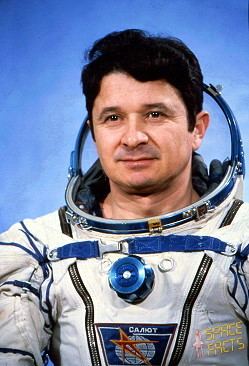Leonid Kizim
Russian - (RFSA)
Deceased
Date of Birth: Aug. 5, 1941
Date of Death: June 14, 2010
Leonid Denisovich Kizim (Кизим Леонид Денисович) (August 5, 1941 – June 14, 2010) was a Soviet cosmonaut. He was selected as a cosmonaut on October 23, 1965. Kizim flew as Commander on Soyuz T-3, Soyuz T-10 and Soyuz T-15, and also served as backup commander for Soyuz T-2. All together he spent 374 days 17 hours 56 minutes in space. On Soyuz T-15, he was part of the only crew to visit two space stations on one spaceflight (Mir and Salyut 7).
Soyuz-U | Soyuz T-3
Russian Federal Space Agency (ROSCOSMOS) | RussiaBaikonur Cosmodrome, Republic of Kazakhstan
Nov. 27, 1980, 2:18 p.m.
Status: Success
Mission:
Soyuz T-3 was the 13th mission to visit the Salyut 6 space station. It was the first Soyuz spacecraft since 1971 that carried three cosmonauts. The mission began on November 27, 1980, 14:18:28 UTC, launching Commander Leonid Kizim, Flight Engineer Oleg Makarov and Research Cosmonaut Gennady Strekalov into orbit. They docked with the station the next day. During their 11-day stay on the station, crew was busy with overhauling and maintenance work on the station, and also carried out usual experiments. The mission concluded with a safe landing back on Earth on December 10, 1980, 09:26:10 UTC.
Low Earth OrbitSoyuz-U | Soyuz T-10
Russian Federal Space Agency (ROSCOSMOS) | RussiaBaikonur Cosmodrome, Republic of Kazakhstan
Feb. 8, 1984, 12:07 p.m.
Status: Success
Mission:
Soyuz T-10 was the third long-duration expedition to the Salyut 7 space station. The mission began on 8 February 1984, 12:07:26 UTC, launching Commander Leonid Kizim, Flight Engineer Vladimir Solovyov and Research Cosmonaut Oleg Atkov into orbit. They docked with the station the next day. During their 237-day stay on the station, crew performed various scientific and medical experiments, performed six EVAs for station maintenance, and were visited by Soyuz T-11 and Soyuz T-12 missions. Soyuz T-10, per usual, swapped vehicles with the Soyuz T-11 crew, which allowed for a longer stay on the station. The mission concluded with a safe landing back on Earth on October 2, 1984, 10:57:00 UTC.
Low Earth OrbitSoyuz-U | Soyuz T-11
Russian Federal Space Agency (ROSCOSMOS) | RussiaBaikonur Cosmodrome, Republic of Kazakhstan
April 3, 1984, 1:08 p.m.
Status: Success
Mission:
Soyuz T-11 was the sixth mission to visit the Salyut 7 space station and the first to visit the long-duration Soyuz T-10 resident crew of the station. The mission began on April 3, 1984, 13:08:00 UTC, launching Commander Yury Malyshev, Flight Engineer Gennady Strekalov and Research Cosmonaut Rakesh Sharma, the first Indian cosmonaut, into orbit. They docked with the station the next day. During their 7-day stay on the station, crew performed various scientific experiments. Soyuz T-11, per usual, swapped their vehicles with the resident Soyuz T-10 crew, which allowed for a longer stay on the station. The crew returned in Soyuz T-11 spacecraft, landing safely back on Earth on October 2, 1984, 10:57:00 UTC.
Low Earth OrbitSoyuz-U2 | Soyuz T-15
Soviet Space Program | RussiaBaikonur Cosmodrome, Republic of Kazakhstan
March 13, 1986, 12:33 p.m.
Status: Success
Mission:
Soyuz T-15 was the last mission to visit the Salyut 7 space station and the first to visit the Mir space station. The mission began on March 13, 1986, 12:33:09 UTC, launching Commander Leonid Kizim and Flight Engineer Volodimir Solovyov into orbit. They docked with Mir two days later. During their stay there, crew tested station's systems and were visited by two Progress cargo spacecrafts. On May 5, 1986, 12:12:09 UTC crew undocked from Mir and docked with Salyut the next day. There they collected experiments results, instruments and performed two EVAs. On June 25 crew undocked from Salyut 7 and returned to Mir the next day. The mission concluded with a safe landing back on Earth on July 16, 1986, 12:34:05 UTC.
Low Earth OrbitThe Roscosmos State Corporation for Space Activities, commonly known as Roscosmos, is the governmental body responsible for the space science program of the Russian Federation and general aerospace research. Soyuz has many launch locations the Russian sites are Baikonur, Plesetsk and Vostochny however Ariane also purchases the vehicle and launches it from French Guiana.
Falcon 9
Dror-1
Space Launch Complex 40 - Cape Canaveral SFS, FL, USANote: SpaceX identifies the mission as "Commercial GTO 1". Dror-1 is a geostationary communication satellite built and developed by Israel Aerospa…
Falcon 9
Starlink Group 10-28
Space Launch Complex 40 - Cape Canaveral SFS, FL, USAA batch of 28 satellites for the Starlink mega-constellation - SpaceX's project for space-based Internet communication system.
Soyuz 2.1a
Progress MS-31 (92P)
31/6 - Baikonur Cosmodrome, Republic of KazakhstanProgress resupply mission to the International Space Station.
Long March 4C
Shiyan 28 B-01
Launch Complex 3 (LC-3/LA-1) - Xichang Satellite Launch Center, People's Republic of ChinaSatellite officially named for "space environment detection" purposes, exact details unknown.
Falcon 9
Starlink Group 10-25
Space Launch Complex 40 - Cape Canaveral SFS, FL, USAA batch of 27 satellites for the Starlink mega-constellation - SpaceX's project for space-based Internet communication system.




